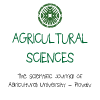Biological and conventional production of industrial crops
|
Course title: |
Biological and conventional production of industrial crops |
|
|
Course code: |
AFBPC |
|
|
ECTS: |
5 |
|
|
In-class hours |
Lectures: |
30 |
|
Laboratory work/Tutorials: |
30 |
|
|
Self-preparation hours |
Practical training: |
15 |
|
Other: |
50 |
|
|
Total hours: |
125 |
|
|
Language: |
English |
|
|
Study cycle: |
BSc, MSc |
|
|
Semester: |
Winter & Summer |
|
|
Faculty: |
Faculty of Agronomy |
|
|
Name of the lecturer(s): |
Assist. Prof. Rumyana Georgieva, PhD |
|
|
Mode of delivery: |
Face-to-face, distance learning |
|
|
Prerequisites: |
Botany, Plant physiology, Soil science and agrochemistry, Phytopathology, Entomology |
|
|
Learning outcomes of the course unit: |
The course “Biological and Conventional Production of industrial crops” provides biology, systematics and varieties introduction. The aspects of the conventional and biological production by this group of crops are also presented. The course includes lectures, laboratory work and practices. |
|
|
Course contents: |
Lectures - 30 1. Industrial rops – history, utilization and distribution. Classification of the industrial crops – 2 hours 2. Biological farming practices – 2 hours 3. Sugar beet. Origin, distribution, importance. Productivity potential. Phenology and biological characteristics. Agro-technology (predecessors, soil tillage, fertilization, sowing, growing during the vegetation period, harvesting, biological production) – 2 hours 4. Ethanol production of sugar crops-– 2 hours 5. Potatoes. Origin, distribution, importance. Productivity potential. Phenology and biological characteristics. Agro-technology (predecessors, soil tillage, fertilization, sowing, growing during the vegetation, harvesting, biological production) – 2 hours 6. Cotton. Origin, distribution, importance. Productivity potential. Phenology and biological characteristics. Agro-technology (predecessors, soil tillage, fertilization, sowing, growing during the vegetation, harvesting, biological production) – 2 hours 7. Flax. Origin, distribution, importance. Productivity potential. Phenology and biological characteristics. Agro-technology (predecessors, soil tillage, fertilization, sowing, growing during the vegetation, harvesting, biological production) – 2 hours 8. Industrial hemp. Origin, distribution, importance. Productivity potential. Phenology and biological characteristics. Agro-technology (predecessors, soil tillage, fertilization, sowing, growing during the vegetation, harvesting, biological production) – 2 hours 9. Industrial hemp regulations- comparison between Bulgaria and the other countries – 2 hours 10. Sunflower. Origin, distribution, importance. Productivity potential. Phenology and biological characteristics. Agro-technology (predecessors, soil tillage, fertilization, sowing, growing during the vegetation, harvesting, biological production) – 2 hours 11. Peanuts. Origin, distribution, importance. Productivity potential. Phenology and biological characteristics. Agro-technology (predecessors, soil tillage, fertilization, sowing, growing during the vegetation, harvesting, biological production) – 2 hours 12. Sesame. Origin, distribution, importance. Productivity potential. Phenology and biological characteristics. Agro-technology (predecessors, soil tillage, fertilization, sowing, growing during the vegetation, harvesting, biological production) – 2 hours 13. Rapeseed. Origin, distribution, importance. Productivity potential. Phenology and biological characteristics. Agro-technology (predecessors, soil tillage, fertilization, sowing, growing during the vegetation, harvesting, biological production) – 2 hours 14. Oilseed crops as a resource for biodiesel production – 2 hours 15. Tobacco. Origin, distribution, importance. Productivity potential. Phenology and biological characteristics. Agro-technology (predecessors, soil tillage, fertilization, sowing, growing during the vegetation, harvesting, biological production) – 2 hours
Laboratory work - 30h 1. Sugar beet- morphology specifics, systematic and varieties, determination of the sugar content, biological yield - 2 hours 2 Potato - morphology specifics, systematic and varieties, determination of the starch content, biological yield - 2 hours 3. Technological map of potato - 2 hours 4. Cotton- morphology specifics, systematic and varieties - 2 hours 5. Cotton- qualification and biological yield - 2 hours 6. Flax- morphology specifics, systematic and varieties- 2 hours 7. Industrial hemp- morphology specifics, systematic and varieties - 2 hours 8. Sunflower- morphology specifics, systematic and varieties, qualification and biological yield- 2 hours 9. Technological map of sunflower - 2 hours 10. Rapeseed- morphology specifics, systematic and varieties, qualification and biological yield- 2 hours 11. Peanut- morphology specifics, systematic and varieties - 2 hours 12. Sesame- morphology specifics, systematic and varieties - 2 hours 13. Tobacco- morphology specifics, systematic and varieties - 2 hours 14. Sowing of industrial crops. Determining the depth and time of sowing. Calculation of crop density - 2 hours 15.Assessment of the condition of the field crops - 2 hours |
|
|
Recommended or required reading: |
1. Smith, Albert E. (1995) Handbook of Weed Management Systems. Marcel Dekker. p. 411. ISBN 0-8247-9547-4. 2. Šarapatka B, Urban J (2009) Organic agriculture. IAEI, Prague 3. Bečka, D., Bečková, L., Capouchová, I., Dvořák, P., Fišer, M., Haberle, J., Hamouz, K., Hájková, M., Honsová, H., Hýbl, M. and Janovská, D., 2017. Plant Growing in Organic Farming. University of South Bohemia in České Budějovice. 4. Industrial Crops and Products - Journal - Elsevier 5. Singh, B.P. (2010). Industrial crops and uses. |
|
|
Planned learning activities and teaching methods: |
Lectures, presentations, tutorials, conversation, discussions, brainstorming |
|
|
Assessment methods and criteria: |
The lectures, laboratory work and practical trainings will be held in the laboratories, on the experimental field and the demonstration field of the Crop Science Department, Faculty of Agronomy. During the learning process the students and the lecturer will actively discuss the material. The students are working individually under the lecturer supervision. The final grade consists of: ® Theory exam. (test and discussion). (Origin, distribution, importance. Phenology and biological characteristics. Agro-technology). – 60% ® Practical exam. (discussion). (Determination of the species by their morphological specifics) – 20% ® Presentation of an individual project about selected industrial crop – 20% |
|
 - Events on the occasion of the 80th anniversary of AU
- Events on the occasion of the 80th anniversary of AU











